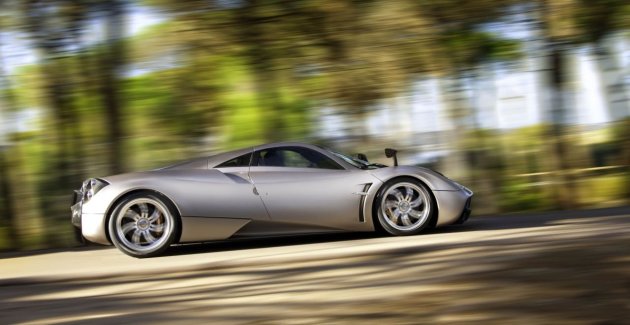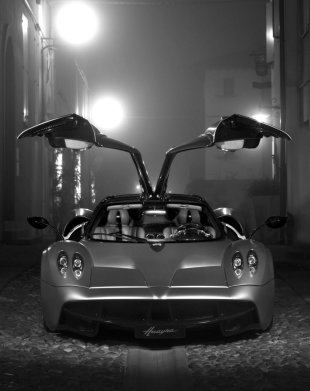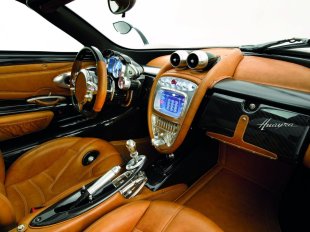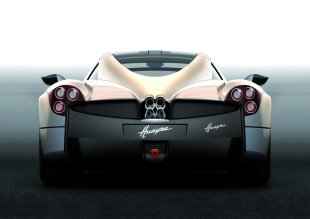
The Huayra is the follow-up to the Zonda, the debut model from self-taught supercar auteur Horacio Pagani. It features an all-new chassis with a central monocoque made from titanium-infused carbon fiber, and the wheelbase has been stretched 2.75 inches over the Zonda. The suspension is pure race car stuff: double wishbones milled from billets of a copper-rich aluminum alloy called Avional, with pushrod-actuated Ohlins shocks.
The carbon bodywork was styled by Pagani himself, and features active aerodynamics -- flaps at each corner of the car that can move independently and alter downforce according to inputs from sensors that measure speed, lateral and longitudinal acceleration, roll, and steering angle. The suspension will also automatically lower the nose to increase the car's angle of attack and increase downforce at speed.
Here's the simple math: The Huayra weighs less than 3000 pounds (dry) and has 720 horsepower. Oh, and it also has more than 737 lb-ft of torque, courtesy of a new 60-degree, 6.0-liter twin-turbo V-12 developed expressly for the car by the engine wizards at AMG, replacing the 7.3-liter naturally aspirated AMG V-12 in the Zonda. The mid-mounted engine drives the rear wheels through a seven-speed, single clutch automated manual transmission built by Xtrac, the British company that makes trannys for F1 cars and Le Mans prototypes.
There was some wrangling over the new engine's configuration. Horacio Pagani didn't like the idea of turbos, and didn't like the naturally aspirated V-8 AMG first proposed as a replacement for the Zonda's 7.3. He wanted a V-12, but AMG engineers were insistent that to meet emissions and fuel consumption standards through the next decade, the engine had to have forced induction. AMG clearly knew what it was talking about. At cruising speeds, the Huayra is one of the most fuel-efficient supercars in the business, says Pagani, brandishing figures fresh from the test lab showing it has achieved 21 mpg (U.S.) on the Euro highway cycle.
Nailing the gas in the Huayra is like lighting the afterburners on an F-15, though. The new V-12, codenamed M158 in AMG-speak, will pull cleanly and smoothly from as little as 1000 rpm, but once the tach needle swings past the 2500 mark and the turbos get into their comfort zone, the thrust is epic and utterly relentless all the way to 6000 rpm. I didn't go past 160 mph more than once on the bumpy, busy autostrada near Bologna, but the Huayra got there without breaking sweat; a casual canter en route to its claimed 230 mph top speed.
More impressive than the Huayra's raw speed on the autostrada, however, is its agility on the winding two-lanes. This is a big car -- 181.2 inches long and 80.2 inches wide, rolling on a 110.2-inch wheelbase -- but its low mass -- it weighs about 200 pounds less than a Ferrari 458 Italia, and a whopping 1300 pounds less than a Bugatti Veyron -- means it darts and weaves through the twisties like Jerry Rice on a crossing route. Factor in that weapons-grade torque and a complete absence of turbo-lag, and the Huayra will destroy a canyon road using only second and third gears.
Which is just as well, because the seven-speed automated manual transmission is the car's weakest link. Sure, it's light -- at 211 pounds, the single-clutch unit is less than half the weight of the 458 Italia's dual-clutch 'box -- and the F1-style transverse gearset keeps most of the transmission's mass inside the wheelbase, but the speed and finesse of its shifts are nowhere near as good as those of the Ferrari. It feels like a first-gen Lamborghini automated manual -- slow and clumsy in auto mode, thumpingly brutal in manual mode if you keep your foot on the gas through the shifts.
The Huayra's steering isn't quite as tactile as that of the Zonda, but that's because Pagani has deliberately dialed some snooze factor into the chassis in recognition of the way most Huayra owners will actually drive the cars. When pushed hard into turns, the Huayra will eventually develop mild understeer, which Horacio Pagani prefers to the snap oversteer that usually bedevils mid-engine supercars at the limit. "It's safer," he says simply. The brakes, monster carbon-ceramic units developed in partnership with Brembo, are stellar. You can grenade the pedal time after time, and they just keep coming back for more.
Our tester was running on the standard P Zero tires specially developed for the Huayra by Pirelli. The optional P Zero Corsas have proven 20 percent faster on the track, says Pagani, but are 10 percent less efficient in the wet. If I had the money for a Huayra, I'd probably opt for the Corsas to give the car a touch more front end bite on initial turn in, and drive my Bentley Conti GT on rainy days.
Our tester was also only the fifth Huayra ever built. The Pagani shop is tiny and it's production methods artisanal, so development is ongoing. Andrea Galletti, who spent 10 years working for the Ferrari F1 team and helped develop the 599XX, said the variable front ride height settings will be changed to alter the car's angle of attack and improve stability at speed (I mentioned I had been chasing the front end around more than I had expected above 140 mph on the rough autostrada), and that anti-roll bar settings would also be changed to improve initial turn-in response.
A sport + mode is also being developed that will lower the car 10mm, eliminate the auto upshift (which currently happens when you hit the redline in either comfort or sport manual mode), and switch off both traction control and ABS. Galletti also acknowledged that for the typical Huayra customer -- someone who collects supercars and might drive them fast only occasionally -- the transmission needs work to improve comfort and response, particularly when the Huayra is being cruised around town. Among the changes under discussion is a shorter first gear so the engine doesn't rev as high before the clutch engages from a standstill.
Pagani currently holds 14 orders for the Huayra from U.S. customers (out of a total of 95 worldwide), its million dollar-plus price tag notwithstanding. U.S. market homologation, which includes the adoption of two-stage airbags, is expected to be completed by the end of this year, and the first U.S. spec Huayra is expected to be delivered by mid-2013. (The carbon/titanium central tub is so strong it has been used in seven crash tests so far, says Pagani proudly. They simply removed the buckled front and rear subframes after each test, and bolted on new ones.)
Before I drove my first Pagani 10 years ago, an early Zonda, I was a skeptic. I had expected a glorified kit car -- fast, but half-baked. I was surprised at how complete the Zonda felt. It drove and rode and steered like a real car developed by a real car company with thousands of engineers and a basement full of Cray supercomputers at its disposal. The Huayra is no different. Pagani may be tiny -- just 53 people work at the factory at San Cesario sul Panaro, just outside Modena -- but the Huayra is a real car. It has air conditioning and sat-nav and a stereo, all the mod-cons you'd expect in a modern supercar. It's a car in which you could comfortably knock off 1000 miles a day, and feel fresh enough for a chilled Dom Perignon before dinner.
But that's not what makes the Pagani Huayra special. What makes it special is that it's the singular product of one man's singular passion. "We are a design and research company based on the Renaissance theory of art and science working together," says Argentine-born Horacio Pagani. "That's not our idea -- it's 500 years old. We take our inspiration from Leonardo da Vinci." Pagani has thought through every single detail of this car -- his one-on-one walkthrough of the Huayra's technical highlights lasted more than three hours. He is truly autodom's Renaissance man (he named his first son Leonardo): part designer, part engineer, mostly self-taught, totally obsessed.
How else could you explain the fact that every one of the Huayra's 1400 titanium bolts has the Pagani logo etched on it (the pre-production bolt set used on the first five cars cost $112,000 -- per car); that Pagani spent nearly $900,000 developing a unique fuel system designed to eliminate the threat of fires in a crash; that the Huayra has a bespoke battery that's 26 pounds lighter than the one used in the Zonda (the old one cost $125, the new one is more than $1800). There are 1001 other examples I could quote, so just take it from me: The Huayra's detailing and workmanship is simply incredible. It makes a Ferrari look frumpy, a Veyron like a Volkswagen.
A Pagani is more than just a car. It is a rolling work of art, painstakingly created and beautifully rendered. Some Zonda models are now worth considerably more than what their owners paid for them, which perhaps proves the point that great art always goes up in value. But driving the Huayra is a lot more fun than looking at a painting on the wall.
Our tester was running on the standard P Zero tires specially developed for the Huayra by Pirelli. The optional P Zero Corsas have proven 20 percent faster on the track, says Pagani, but are 10 percent less efficient in the wet. If I had the money for a Huayra, I'd probably opt for the Corsas to give the car a touch more front end bite on initial turn in, and drive my Bentley Conti GT on rainy days.
Our tester was also only the fifth Huayra ever built. The Pagani shop is tiny and it's production methods artisanal, so development is ongoing. Andrea Galletti, who spent 10 years working for the Ferrari F1 team and helped develop the 599XX, said the variable front ride height settings will be changed to alter the car's angle of attack and improve stability at speed (I mentioned I had been chasing the front end around more than I had expected above 140 mph on the rough autostrada), and that anti-roll bar settings would also be changed to improve initial turn-in response.
A sport + mode is also being developed that will lower the car 10mm, eliminate the auto upshift (which currently happens when you hit the redline in either comfort or sport manual mode), and switch off both traction control and ABS. Galletti also acknowledged that for the typical Huayra customer -- someone who collects supercars and might drive them fast only occasionally -- the transmission needs work to improve comfort and response, particularly when the Huayra is being cruised around town. Among the changes under discussion is a shorter first gear so the engine doesn't rev as high before the clutch engages from a standstill.
Pagani currently holds 14 orders for the Huayra from U.S. customers (out of a total of 95 worldwide), its million dollar-plus price tag notwithstanding. U.S. market homologation, which includes the adoption of two-stage airbags, is expected to be completed by the end of this year, and the first U.S. spec Huayra is expected to be delivered by mid-2013. (The carbon/titanium central tub is so strong it has been used in seven crash tests so far, says Pagani proudly. They simply removed the buckled front and rear subframes after each test, and bolted on new ones.)
Before I drove my first Pagani 10 years ago, an early Zonda, I was a skeptic. I had expected a glorified kit car -- fast, but half-baked. I was surprised at how complete the Zonda felt. It drove and rode and steered like a real car developed by a real car company with thousands of engineers and a basement full of Cray supercomputers at its disposal. The Huayra is no different. Pagani may be tiny -- just 53 people work at the factory at San Cesario sul Panaro, just outside Modena -- but the Huayra is a real car. It has air conditioning and sat-nav and a stereo, all the mod-cons you'd expect in a modern supercar. It's a car in which you could comfortably knock off 1000 miles a day, and feel fresh enough for a chilled Dom Perignon before dinner.
But that's not what makes the Pagani Huayra special. What makes it special is that it's the singular product of one man's singular passion. "We are a design and research company based on the Renaissance theory of art and science working together," says Argentine-born Horacio Pagani. "That's not our idea -- it's 500 years old. We take our inspiration from Leonardo da Vinci." Pagani has thought through every single detail of this car -- his one-on-one walkthrough of the Huayra's technical highlights lasted more than three hours. He is truly autodom's Renaissance man (he named his first son Leonardo): part designer, part engineer, mostly self-taught, totally obsessed.
How else could you explain the fact that every one of the Huayra's 1400 titanium bolts has the Pagani logo etched on it (the pre-production bolt set used on the first five cars cost $112,000 -- per car); that Pagani spent nearly $900,000 developing a unique fuel system designed to eliminate the threat of fires in a crash; that the Huayra has a bespoke battery that's 26 pounds lighter than the one used in the Zonda (the old one cost $125, the new one is more than $1800). There are 1001 other examples I could quote, so just take it from me: The Huayra's detailing and workmanship is simply incredible. It makes a Ferrari look frumpy, a Veyron like a Volkswagen.
A Pagani is more than just a car. It is a rolling work of art, painstakingly created and beautifully rendered. Some Zonda models are now worth considerably more than what their owners paid for them, which perhaps proves the point that great art always goes up in value. But driving the Huayra is a lot more fun than looking at a painting on the wall.






No comments:
Post a Comment